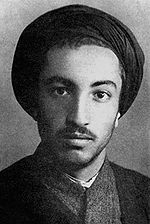- Navvab Safavi
-
 Navvab Safavi, leader of the group Fadayan-e Islam
Navvab Safavi, leader of the group Fadayan-e Islam
Navvab Safavi (born Mojtaba Mir-Lowhi) (1924 – 1955) was a cleric responsible for founding of the Fadayan-e Islam group and with them the assassination of several leading Iranians, primarily politicians.
Contents
Early life
Born in Khānīābād (southern Tehran), Safavi studied in Najaf, Iraq and worked in Abadan's petroleum installations in the province of Khuzestan for a while. He is said to have been known for his striking looks and his "mesmerizing" speaking ability.[1]
Career
He founded the Fadayan-e Islam organization in 1946, and began recruiting like-minded individuals. Like the Ikhwan (Muslim Brotherhood), Navvab-Safavi believed that Islamic society needed to be purified. To do this he organized carefully planned assassinations to rid Islam of "corrupting individuals," often prime ministers of Iran's government.
He is said to be "the man who introduced Ayatollah Khomeini to the Muslim Brotherhood and their ideas," who "spent long hours together" with Khomeini in discussion, and visited him in Qom on a number of occasions during 1943 and 1944.[2]
He and his organization were responsible for the assassinations, or attempted assassinations of politicians Abdolhosein Hazhir, Hossein Ala (he survived the attempt), Prime Minister Haj Ali Razmara, historian Ahmad Kasravi, and Major General Teymur Bakhtiar.
Safavi and his group were closely associated with Ayatollah Abol-Ghasem Kashani and supported but were not members of Mohammed Mosaddeq's National Front. Safavi worked with Kashani, helping organize bazaar strikes against Premier Ahmad Qavam, public meetings in support of Palestinian Arabs, and a violent demonstration in 1948 against Premier Abdolhossein Hazhir.[3] When the Shah appointed National Front leader Dr. Mohammed Mossadegh to the post of prime minister, Safavi expected his objectives would be furthered.[citation needed] He demanded the government drive the British out, and that it release "with honor and respect" the assassin of Razmara. When that didn't happen, Safavi announced "We have broken away irrevocably from Kashani's National Front. They promised to set up an Islamic country according to the precepts of the Koran. Instead they have imprisoned our brothers." He later warned, "There are others who must be pushed down the incline to hell."[citation needed]
However relations between Kashani and Safavi, not to mention Mosaddeq, became "strained." On 10 May 1951, Navvab Safavi declared: 'I invite Musadizz, other members of the National Front and Ayatollah Kashani, to an ethical trial,`[4]
Arrest and execution
Prime Minister Mosaddeq, who was preocupied with the nationalization of the oil industry, found these activities "disruptive." On June 8, 1951 he ordered the arrest of Safavi, who stayed there until his release in February 1953. Six months later Mosaddeq was overthrown in a coup d'état. Like Kashani, Safavi supported the coup against Mosaddeq and "in the years immediately following the coup Navvab Safavi enjoyed a close association with the court and the government of Prime Minister General Fazlollah Zahedi." By 1955 it became clear the regime would not be instituting strict enforcement of Shariah law and Islamizing Iran, and was instead becoming more pro-Western. On 22 November, after an unsuccessful attempt to assassinate Hosein Ala, Navvab Safavi and some of his followers were arrested. Following a summary trial Safavi and three other members of Fadayan-e Islam were executed on 25 December. The clerical establishment did not attempt to intervene on their behalf.[4]
Legacy
The Islamic Republic of Iran considers him an Islamic hero and martyr, and an expressway and metro stop are named after him in Tehran.
See also
- Fadayan-e Islam
- Pahlavi Dynasty
- List of Prime Ministers of Iran
- History of fundamentalist Islam in Iran
References
- ^ Taheri, The Spirit of Allah, (1985), p.98
- ^ Taheri, The Spirit of Allah (1985), p. 98, 102.
- ^ Ervand Abrahamian, Iran between Two Revolutions (Princeton University Press, 1982), pp. 258-9.
- ^ a b Islamic Utopia in Pre-Revolutionary Iran: Navvab Safavi and the Fada'ian-e Eskam by Sohrab Behdad Middle Eastern Studies, January 1997
- Avsati, Alireza, Iran in the last 3 Centuries, Published Tehran, 2003. Vol1 ISBN 964-93406-6-1 Vol2 ISBN 964-93406-5-3.
- Mazandi, Yousof (United Press Iranian correspondent) and Edwin Muller, Government by Assassination, Reader's Digest, September 1951.
- Taheri, Amir. The Spirit of Allah Khomeini and the Islamic revolution, Bethesda, Maryland : Adler & Adler, c1985
External links
- Bio According to RajaNews (dead link)
Categories:- Iranian clerics
- People executed for murder
- People executed by firing squad
- People from Tehran
- 1924 births
- 1955 deaths
- Iranian assassins
- People executed by the Pahlavi dynasty
- Executed Iranian people
- 20th-century executions
- Deaths by firearm in Iran
- People convicted of murder by Iran
- Iranian people convicted of murder
Wikimedia Foundation. 2010.


